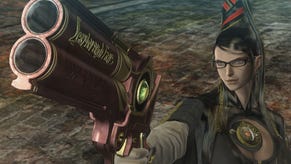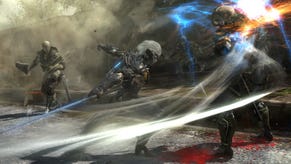Replaying Revengeance: Difficulty, Mastery And Fighting
FIGHTENING STRIKES TWICE!!!!
One of the downsides of being a games journalist (violins please) is that you don't play many games that aren't also 'work.' I secretly indulge a Counter Strike habit and the odd round of Hearthstone behind the sheds, sure, but mostly I play stuff I'm writing about or might write about. To break into that cycle takes a special kind of game. Something unique in style and structure. Which is another way to say I can't stop replaying Metal Gear Rising: Revengeance.
Hit the jump to learn of ZANDATSU.
Revengeance is of a genre that's never found a natural home on the PC, and so perhaps deserves a little more attention than it's received – because it's one of the greatest 3D combat systems ever, a precision masterpiece built around an irresistible hook. This genre is also often misunderstood in terms of total running time or the cutscene-based narratives, both of which are irrelevant next to the true purpose. Stylish fighting, and plenty of it.
I've played it through on Hard and Very Hard, and am now hitting Revengeance difficulty. This raises the question of what difficulty levels are for, and what they mean for different types of game. Certain elements of the gaming community wear difficulty levels as a badge, a literal achievement, and decry those (like me) who prefer to have a 'normal' time in most FPSs and games in general. Difficulty has negative connotations, because we've all played games where what it means is the enemy damage and accuracy goes through the roof. No fun.
For games like Revengeance it's different. Here the difficulty levels are almost like the game's framework; to put it very simply, your own increasing mastery of the combat system is matched by an ever-increasing intelligence and ferocity on the part of enemies. In Revengeance it doesn't feel that the baddies necessarily start hitting harder, though they do keep pace with your ever-stronger body, but that they're becoming more capable and smarter about how they engage. Some gain new moves and all have mixed-up attack patterns, meaning that you're always just on the edge of mastering them rather than ever quite being able to do it.
'Replayability' is thought of as a distinct part of a game's appeal, yet in the case of something like Revengeance it really is everything. This is not about alternative story branches or new areas to discover, but a core system that is so flexible and large that it has to be gradually unfolded to new players. Mastery of one strata leads onto another, and this is not a question of memorising combos. Think of it more like a tree diagram – an enormous tree, stretching far out and up with countless sub-branches to follow. Then imagine there are shortcuts all over the tree from one fork to another. This is Raiden's potential moveset and you cannot memorise a structure like it, so instead you learn to climb with style.
Ask the name of a single combination or its exact sequence of button presses in Revengeance, and I'd return a blank stare. This is a system you come to feel your way around, so you always know that from certain angles a heavy attack will bring Raiden's heel down in a slam, from where you can either continue to press with another heavy and into the launch or pull out / parry with light attacks. From that launch you could follow him up into the air or re-focus the next heavy on approaching foes, always leaving room for the parry, or switch to a light offense if there are lots of humanoid (ie superfast) enemies in the mob. These decisions are made in split-seconds during Revengeance's full-on battles, and the only way to even approach dealing with them is to be reactive.
I've now been playing Revengeance for over a year, because I ran through it on all difficulties on PS3 before the recent Steam release and jazzier visual effects / all DLC, pulled me right back in. And when you have that kind of perspective on a game the root themes seem more obvious. Revengeance is the first of these types of fighters I've played where the goal is permanent offense – Raiden should always be attacking enemies in all circumstances, unless he's parrying or sprinting towards them. The vast majority of action games give you the tools to get things done and then some, but I've never played one that so focuses the player around being the aggressor. The only way to avoid being hit, in fact, is to be constantly moving and attacking
The 'Zandatsu' system fits into this rhythm beautifully; when an enemy is stunned or sufficiently weakened, you can put the game into slow-mo and with one precise slice rip out their cyborg spine and very being. It's hot, and definitely not gratuitous. But it's also a technique that can be triggered into its own unique animations or used in the midst of pre-existing animations, for example Raiden's slide. So although there are flagged Zandatsu moments, you can also trigger a kind of 'full-manual' mode to disembowel enemies from nearly any angle. Revengeance uses tiny freeze-frames during combat to highlight potential Zandatsus, which are almost too short to react to, but like mastering a pinball table their angles and pacing ingrain themselves over hours.
This is an example of how one technique – the Zandatsu – complements the more furious core fighting system of Revengeance. But it couldn't also pass with a comment on the theme. Even in this fantastical technological dystopia, Raiden is samurai. The archetype or the calling-card of the samurai across Western media is an animation; the sword held by the waist, followed by a movement that leaves the blade in the air and the opponent sliced. In the Zandatsu of Revengeance, therefore, you see not just a brilliant and stylish system but a link and homage to its source. Few developers outside of Platinum hit such peaks of mechanical refinement.
Not everyone loves 3D fighting games, with their surface impression of restricting corridors and comic-book violence, but I am one that sees their beauty. Here's a funny thing. I don't watch action movies anymore, because thanks stuff like Revengeance it feels boring watching a stuntman 'dodge' a bullet or act out a swordfight. It must be the passivity. Because I know that, within worlds like this, it's possible to be the kind of action god that makes Hollywood look like Thunderbirds.
One of Revengeance's little tricks, though really it's the whole act, is to mix up the types of baddies you face on higher difficulties. These simple changes in group dynamics are there to confuse players with a static plan, and they do. It's when you learn how to roll with the unexpected that Revengeance becomes expressive, as mashing gives way to perfectly-timed taps and counters, and fingers almost without bidding are setting up the next move.
The incredible number of routes through even one 'chain' of Raiden's attacks, when you add in things like cancels and parries and held-combos, makes each miniature sequence in a fight a show-stopper with room for endless flourishes – or an instant, devastating Zandatsu. The reason people often use dancing metaphors when discussing high-quality fighting games is, I think, because control over a system like this can come to feel like an expressive skill, a way of being within the bounds of a monitor. By the time you've reached the stage in Metal Gear Rising of cleaning house with perfect parries and an unbroken combo, you don't stand in the aftermath and think "Raiden did that." You know, you feel, that you did.














